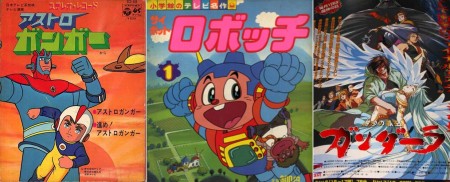Ask John: What are the Worst Anime of the ’60s to ’90s?

Question:
What are the worst anime of the 60-90’s?
Answer:
Asserting any sort of comprehensive summary of forty years of anime history is a practically impossible task, so inevitably my effort will be limited to the extent of my own knowledge and will contain omissions.I haven’t seen every anime. I’m not familiar with every anime. For example, Dororo is the only ’60’s anime television series that I’ve watched from beginning to end. I’ve watched representative full episodes of over 40 anime television series broadcast in the 1960s, but that still accounts for only about two-thirds of the era’s shows. Furthermore, speaking as a fan and supporter of anime, I do believe that every anime production deserves respect for merely existing as a completed work of collaborative artistic effort. But judging relative quality is absolutely necessary, not so much to ostracize the bad but to recognize the exceptional.
Weekly TV anime series first debuted in 1963. The early ’60’s were typified by a number of derivative programs, including Uchu Shonen Soran, Uchu Ace, Yusei Shonen Papi, Yusei Kamen, and Rainbow Sentai Robin, but generally the ’60’s didn’t turn out “bad” anime. 1967’s Skyers 5 is academically interesting as anime’s first attempt to emulate the James Bond-style spy action genre, but in execution the effort just wasn’t very exciting. 1968’s Sabu to Ichi Torimon Hikae and 1969’s Tiger Mask both had strong stories crippled by particularly limited animation.
Studio Knack is an easy target because the studio deserves shame for its typically weak productions. The 1972 Seigi wo Aisuru Mono Gekkou Kamen and Astroganger television series from Studio Knack suffer from poor production values. The studio’s 1973 series Chargeman Ken is now recognized as one of the worst anime series ever released because so little investment and effort was put into its production. The studio’s 1976 robot anime Grozier X has a small following because it was created by Go Nagai, but the show is still poorly animated and not tremendously interesting or exciting. Tatsunoko’s 1976 robot anime Gowapper 5 Godam is historically significant for being the first robot anime to star a girl, but the show itself is a clunky, stilted hybrid of dull robot action and bad slapstick comedy. Toei’s 1976 Speed Racer-inspired Machine Hayabusa is one of anime’s rare “so bad it’s good” titles because it’s so ridiculous. Nippon Animation’s 1976 series Blocker Gundan 4 Machine Blaster is one of the era’s best examples of completely derivative, uninspired robot anime made entirely to cash in on the popularity of robot anime at the time. I can’t really call director Rintaro’s 1974 children’s sci-fi/fantasy anime series Hoshi no Ko Chobin “bad,” per se, but I did find the alien creature Chobin exceptionally aggravating, which made the show a chore to watch.
Studio Knack continue operation into the early 1980s. The studio’s 1981’s Manga Mitokomon had admirable origins, but the show itself was such an uneven mix of slapstick comedy, tired cliché, and effort at being a serious historical drama that it ended up feeling like a parody of itself. Knack’s 1982 Cybot Robotchi was a blatant and less creative rip-off of Toei’s hit Dr. Slump television series from the prior year. With the exception of Chargeman Ken, every title I’ve mentioned so far has been weak or slightly below average but not exceptionally bad. Truly awful anime didn’t start to appear until the OVA boom of the mid and late 1980s. Even shows like 1984’s canceled Cho Kosoku Galvion are “average” rather than “bad.” Most of the bad anime from the 1980s came in the form of OVAs because TV series had to be good enough to sustain a weekly TV viewing audience or risk cancellation. OVAs, however, could be cheap and sloppily produced one-shots, so the golden era gave us stinkers such as Bavi-Stock, Love Position: Halley no Densetsu, Roots Search, Crystal Triangle, LilyC.A.T., Explorer Woman Ray, and Dog Soldier.
The trend of cheap, dull, uninspired OVAs continued but tapered off in the 1990s with titles like D-1 Devestator (1992) and 1995’s Landlock & Bounty Hunter the Hard. The 1996 Dunbine revival effort OVA series Byston Well Monogatari: Garzey no Tsubasa represents one of the lowest points of 90’s anime productions. The early 1990s produced a selection of anime TV series that weren’t exceptionally bad but just weren’t very interesting, including 1990’s RPG Densetsu Hepoi, 1994’s Shinken Densetsu Tight Road, and 1995’s Kuso Kagaku Sekai Gulliver Boy & Juu Senshi Gulkeeva. 1997’s Hallelujah II BOY had an amusing premise but bland execution. 1994’s live-action & anime educational show Gene Diver wasn’t so much “bad” as just forgettable. The stylistic revival series, 1997’s Kyuumei Senshi Nanosaver, was painful to watch because of its roundly uninspired acting, primitive CG, and bland anime segments. 1997’s Next Senki Ehrgeiz and 1998’s Nessa no Haou Gandalla and DT Eightron television series attempted to have unconventional stories, but weak direction and a sense of purposelessness sunk all three shows into irrelevancy. 1999’s Masou Kishin Cybuster finished out the decade by disappointing with poor production values and a soundly uninteresting story.
Add a Comment
You must be logged in to post a comment.


Cho Kosoku Galvion looks like it would’ve been kick-ass!
The opening is pretty awesome.